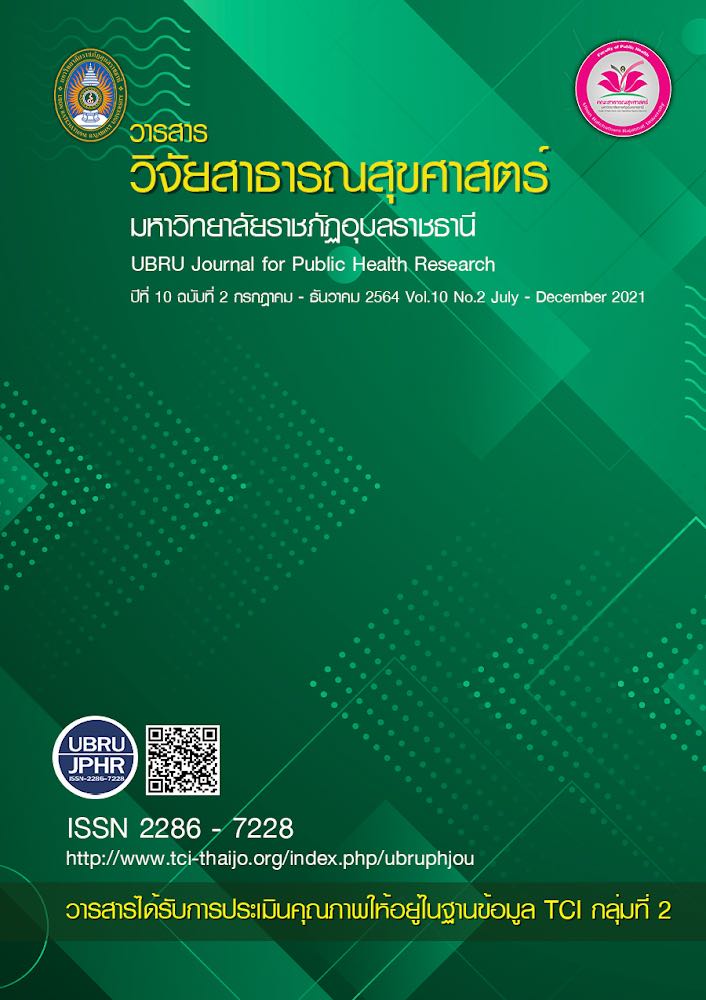ปัจจัยที่มีความสัมพันธ์กับความรู้สึกไม่สบายคอ ไหล่ หลัง และหัวเข่าของบุคลากรมหาวิทยาลัยราชภัฏพระนครศรีอยุธยา
คำสำคัญ:
กล้ามเนื้อและกระดูกโครงร่าง, คอ ไหล่ หลัง หัวเข่า, บุคลากรมหาวิทยาลัยบทคัดย่อ
การวิจัยนี้มีวัตถุประสงค์เพื่อศึกษาปัจจัยที่มีความสัมพันธ์กับความรู้สึกไม่สบายคอ ไหล่ หลัง และหัวเข่าของบุคลากรมหาวิทยาลัยราชภัฏพระนครศรีอยุธยา เป็นการศึกษาเชิงวิเคราะห์แบบภาคตัดขวาง เก็บข้อมูลด้วยแบบสอบถาม กลุ่มตัวอย่าง จำนวน 219 คน จากการสุ่มอย่างง่าย
ผลการศึกษา พบว่า ปัจจัยที่มีความสัมพันธ์กับความรู้สึกไม่สบายลำคอมากที่สุด ได้แก่ การทำงานที่ทำให้เกิดความเครียดเป็นอย่างมาก (OR = 2.71) และการต้องนั่งทำงานเวลานาน มากกว่าครึ่งหนึ่งของเวลาทำงานทั้งหมด (OR = 2.70) ปัจจัยที่มีความสัมพันธ์กับความรู้สึกไม่สบายไหล่มากที่สุด ได้แก่ การก้มหรืองอตัวขณะทำงานเสมอๆ (ไหล่ซ้าย OR = 2.34 , ไหล่ขวา OR = 2.14) และ การยกของที่มีลักษณะเทอะทะ ไม่มีที่จับ หรือถือลำบาก (ไหล่ซ้าย OR = 2.31 , ไหล่ขวา OR = 2.72) ปัจจัยที่มีความสัมพันธ์กับความรู้สึกไม่สบายหลังส่วนบนมากที่สุด คือ ลงน้ำหนักตัวไปข้างใดข้างหนึ่ง หรืออยู่ในท่าที่ไม่สมดุลเสมอๆ (OR = 2.30) ปัจจัยที่มีความสัมพันธ์กับความรู้สึกไม่สบายหลังส่วนล่างมากที่สุด ได้แก่ การเพ่ง จดจ่อ ใช้สายตาเป็นอย่างมาก (OR = 5.36) และการต้องนั่งทำงานเป็นเวลานาน มากกว่าครึ่งหนึ่งของเวลาทำงานทั้งหมด (OR = 2.44) ปัจจัยที่มีความสัมพันธ์กับความรู้สึกไม่สบายหัวเข่ามากที่สุด ได้แก่ อายุ 50 ปี ขึ้นไป เมื่อเทียบกับอายุ น้อยกว่า 30 ปี (OR = 3.75) และการลงน้ำหนักตัวไปข้างใดข้างหนึ่งหรืออยู่ในท่าที่ไม่สมดุลเสมอ ๆ (OR = 3.16)
ดังนั้น บุคลากรมหาวิทยาลัยจึงควรมีการเปลี่ยนอริยาบทอยู่เสมอ ไม่อยู่ในท่าทางที่ไม่สมดุล และหลีกเลี่ยงการจ้อง เพ่งใช้สายตานานๆ การยกของหนัก เทอะทะ นอกจากนี้ควรมีการบริหาร ยืดเหยียดร่างกาย เพื่อป้องกันการเกิดความรู้สึกไม่สบายดวงตา คอ ไหล่ หลัง และหัวเข่า และลดอาการไม่สบายดังกล่าว
เอกสารอ้างอิง
กองโรคจากการประกอบอาชีพและสิ่งแวดล้อม กรมควบคุมโรค กระทรวงสาธารณสุข. (2561). รายงานสถานการณ์ โรคและภัยสุขภาพจากการประกอบอาชีพและสิ่งแวดล้อม ปี 2561. ค้นเมื่อ 18 ตุลาคม 2562, จากhttp://envocc.ddc.moph.go.th/uploads/situation2/2561/2561_01_envocc_situation.pdf
จิตตาภรณ์ มงคลแก่นทราย และอุไรวรรณ หมัดอ่าดัม. (2562). ศึกษาปัจจัยที่มีความสัมพันธ์กับความผิดปกติของระบบโครงร่างและกล้ามเนื้อของบุคลากรสำนักงาน มหาวิทยาลัยวลัยลักษณ์. วารสารวิชาการสาธารณสุข. 28(2), 37-44.
ธรรญญพร วิชัย และปิยะวดี ทองโปร่ง.(2559). ความชุกของอาการปวดหลังของบุคลากรในมหาวิทยาลัยราชธานี จังหวัดอุบลราชธานี. เอกสารประกอบการประชุมวิชาการและนําเสนอผลงานวิจัยระดับชาติ ราชธานีวิชาการ ครั้งที่ 1 มหาวิทยาลัยราชธานี วันที่ 29 กรกฎาคม 2559, อุบลราชธานี, มหาวิทยาลัยราชธานี
เมธินี ครุสันธิ์ และสุนิสา ชายเกลี้ยง. (2557). ความชุก ความรู้สึกไม่สบายบริเวณ คอ ไหล่และหลังของพนักงานสำนักงานของมหาวิทยาลัยที่ใช้คอมพิวเตอร์แบบตั้งโต๊ะมากกว่า 4 ชั่วโมงต่อวัน. เอกสารประกอบการประชุมวิชาการเสนอผลงานวิจัยระดับบัณฑิตศึกษา ครั้งที่ 15 : The 15th Graduate Research Conferences มหาวิทยาลัยขอนแก่น 28 มีนาคม 2557, ขอนแก่น, มหาวิทยาลัยขอนแก่น.
สำนักโรคจากการประกอบอาชีพและสิ่งแวดล้อม กรมควบคุมโรค. (2560). แบบประเมินความเสี่ยงอาการผิดปกติของระบบโครงร่างกระดูกและกล้ามเนื้อ สำนักโรคจากการประกอบอาชีพและสิ่งแวดล้อม กรมควบคุมโรค. ค้นเมื่อ 3 กันยายน 2560, จากhttp://odpc5.ddc.moph.go.th/groups/Academic/images/stories/env/เอกสารการดำเนินงานENVOCC2560/1.งานแรงงานในชุมชน%20(แรงงานนอกระบบ)/8.แบบประเมินความเสี่ยงอาการผิดปกติของระบบบโครงร่างกระดูกและกล้ามเนื้อ.pdf
อูน ตะสิงห์ และชลวิภา สุลักขณานุรักษ์. (2562). ความรู้สึกไม่สบายระบบกล้ามเนื้อและกระดูกของบุคลากรมหาวิทยาลัยราชภัฏพระนครศรีอยุธยา. วารสารราชภัฏกรุงเก่า สาขา วิทยาศาสตร์และเทคโนโลยี. 1(2), 71-82.
Cornell University. (1994). Cornell Musculoskeletal Discomfort Questionnaires (CMDQ). cited 2017 September 3, from http://ergo.human.cornell.edu/ahmsquest.html
ดาวน์โหลด
เผยแพร่แล้ว
รูปแบบการอ้างอิง
ฉบับ
ประเภทบทความ
สัญญาอนุญาต
เนื้อหาและข้อมูลในบทความที่ลงตีพิมพ์ในวารสารวารสารวิจัยสาธารณสุขศาสตร์ มหาวิทยาลัยราชภัฏอุบลราชธานี ถือเป็นข้อคิดเห็นและความรับผิดชอบของผู้เขียนบทความโดยตรงซึ่งกองบรรณาธิการวารสาร ไม่จำเป็นต้องเห็นด้วย หรือร่วมรับผิดชอบใดๆ
บทความ ข้อมูล เนื้อหา รูปภาพ ฯลฯ ที่ได้รับการตีพิมพ์ในวารสารนี้ ถือเป็นลิขสิทธิ์ของวารสารฯ หากบุคคลหรือหน่วยงานใดต้องการนำทั้งหมดหรือส่วนหนึ่งส่วนใดไปเผยแพร่ต่อหรือเพื่อกระทำการใดๆ จะต้องได้รับอนุญาตเป็นลายลักอักษรณ์จากบรรณาธิการวารสารนี้ก่อนเท่านั้น


